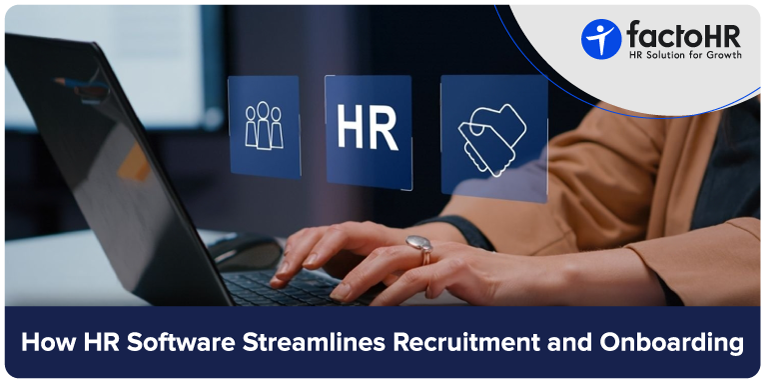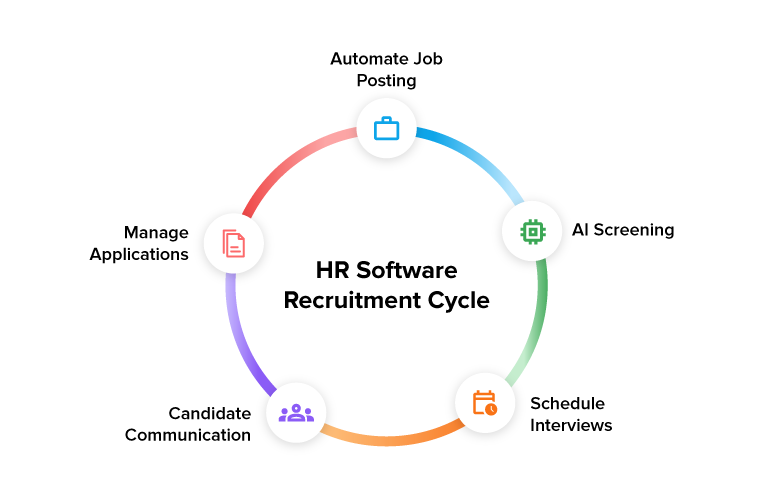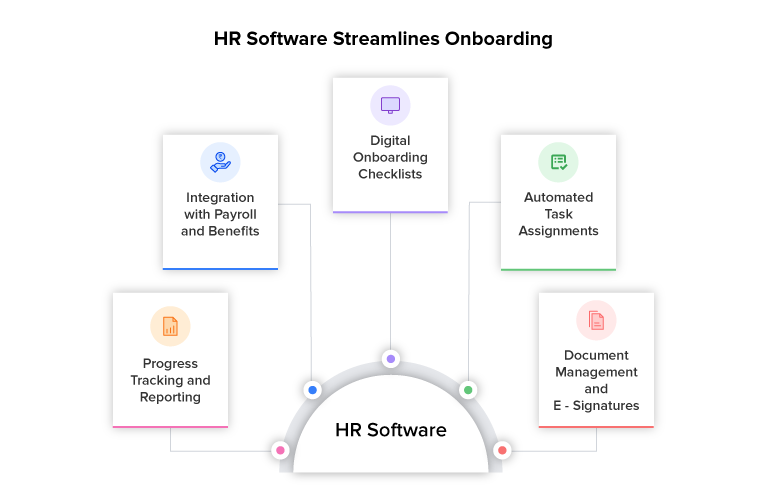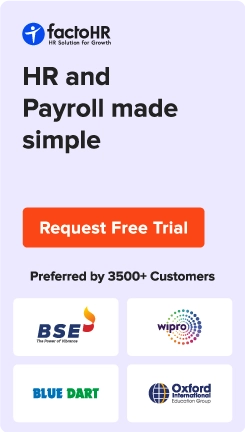How does HR Software Streamline Recruitment and Onboarding

Table of Contents
A successful recruitment and onboarding process is a source of pride for a company and is vital for organizational success. When these processes are managed well, it helps businesses attract top talent. HR software with a streamlined onboarding process ensures new employees are part of the company without any inconvenience. A good recruitment process contributes to employee satisfaction and engagement while improving organizational efficiency.
HR software enables applicant tracking, real-time communication, digital document signature, customized onboarding workflow, and progress monitoring. It saves time and improves department accuracy and stability. Recruitment and onboarding alignment through HR software are important to provide a seamless and positive employee experience. It also helps HR teams maintain compliance, improve reporting, and promote a strong employer brand.

Understanding the Recruitment and Onboarding Process with HR Software
Manual processes frequently lead to delays, miscommunication, data entry errors, and a lack of transparency. Spreadsheets and email chains used for tracking may lead to missed opportunities or compliance problems. The absence of a digital system during onboarding can lead to mismanagement.
Instead of disconnected hiring methods, the HR software brings everything together. Hiring a new employee is a strenuous process. It involves posting jobs on various social media platforms, screening potential candidates, conducting interviews, and ultimately selecting the right person to fill the job opening.
Onboarding this new employee is a whole different task. Once a candidate is finalized and agrees to join a company, HR is responsible for onboarding them. It involves completing all the paperwork related to hiring, introducing them to the company, training them, and setting them up with everything they need for their job.
Using HR software would simplify both these tasks. It provides a centralized platform for monitoring and managing all hiring and onboarding processes.
Breaking down the Recruitment Process
Job Posting
Creating job descriptions that explain what the job involves, what qualifications are needed, and what the expectations are. These postings get spread out on different platforms.
Applicant Tracking
HR software usually has Applicant Tracking Systems (ATS) that help recruiters sort and manage applications easily.
Screening and Interviewing
Screening helps find the best candidates for the job, while interviews give a better idea of candidates’ skills, experience, and fit with the team.
Selection and Offer
Once the ideal candidate is chosen, the final step is to extend an offer. HR software facilitates this process by automating the creation of offer letters.
Break down the Onboarding Process
Pre-Boarding
During pre-boarding, candidates complete necessary paperwork, receive welcome materials, and have logistics like IT setups, workspace assignments, etc.
First Day/Week
During their initial days, new employees familiarize themselves with the company culture and policies, gain access to essential tools for their roles, and develop a sense of belonging, understanding, and comfort within their environment.
Initial Training
Some new employees need to develop a few skills before they start working. Training helps them gain all the necessary information for their position. Training can involve, but is not limited to, role-specific and compliance training, as well as learning how to navigate different systems.
Performance Check-Ins
Consistent performance evaluations in the early months create opportunities to address challenges, clarify instructions, and celebrate successes.

How HR Software Streamlines Recruitment?
HR software simplifies hiring by automating the entire recruitment management process. It allows HR to quickly shortlist candidates, track application statuses, and maintain a structured talent pool database for recruitment needs. HR software improves efficiency and minimizes administrative burden. Key functionalities that streamline recruitment include:
Applicant Tracking Systems (ATS)
An Applicant Tracking System (ATS) allows recruiters to manage the entire applicant lifecycle from a single platform. It enables parsing resumes, sorting applications, tracking statuses, and facilitating collaboration among hiring teams.
Automated Job Postings
HR software simplifies job advertising by automatically sharing openings on multiple job boards, career websites, and social media platforms. This guarantees a broader audience and consistent messaging while significantly decreasing manual workload.
AI-Powered Screening and Shortlisting
AI tools screen and shortlist candidates more efficiently without human intervention. They can process large datasets in very little time, saving HR professionals a lot of time.
Interview Scheduling Tools
HR software automatically schedules interviews for candidates. It supports real-time calendar synchronization, considers time zone differences, and provides automated reminders for a seamless interview process.
Candidate Communication Platforms
HR software centralizes and streamlines engagement with applicants throughout the recruitment lifecycle. It facilitates prompt and transparent interactions, contributing to a more organized and responsive hiring process.

How HR Software Streamlines Onboarding
HR software enhances the onboarding process for new employees by automating administrative tasks, ensuring everything is in order, and improving the overall experience of joining a new company. It also includes various integrated elements that equip organizations with a well-organized and attractive system to streamline onboarding. The key components of onboarding include:

Digital Onboarding Checklists
HR software provides adaptable checklists that guide new hires through each stage of the onboarding process. These digital lists ensure no important tasks are ignored and help standardize department experiences.
Automated Task Assignments
HR software also utilizes automated workflow technology to assign onboarding tasks to the appropriate people, such as the IT team, managers, and HR staff. This synchronization avoids delays.
Document Management and E-Signatures
HR software facilitates document management and e-signatures. It streamlines handling employee records, contracts, policy documents, and compliance forms.
Integration with Payroll and Benefits
Smooth integration with payroll, performance management, and other HRM functions is a key part of the HR software. It helps manage employee payments accurately and compliantly, reducing manual work and errors.
Progress Tracking and Reporting
HR software allows managers to monitor their employees in real time. With customizable dashboards and automated reports, it delivers data-driven insights. An HR manager can identify areas for development and assess workforce effectiveness.

What are the Benefits of Streamlining Recruitment and Onboarding with HR Software
Utilizing HR software to manage the hiring and onboarding process improves candidate experience and efficiency. When repetitive tasks are automated and information is centralized in one location, businesses can reduce the time spent on onboarding and recruitment.
Efficient Hiring
HR software enhances hiring with automated workflows, applicant tracking, and AI-driven screening. The entire recruitment lifecycle, from hiring to onboarding, becomes smooth.
Enhance Candidate Experience
Proper communication, well-organized onboarding, and digital documents give candidates a smooth and professional experience.
Accurate Compliance Management
Digitizing document management and using e-signatures saves time on manual data entry and ensures compliance with legal and company requirements.
Seamless Department Coordination
Automated task assignments and connections between different departments promote better coordination among HR, IT, and payroll departments, which minimizes mistakes and delays.
Data-Driven Insights and Reporting
The built-in analytics provide real-time visibility into the recruitment and onboarding metrics, enabling constant improvement through informed decision-making.

What are the Future Trends in HR Software for Recruitment and Onboarding
HR software is essential for seamless recruitment and onboarding, enabling HR teams to make informed decisions based on real-time data. AI-driven software optimizes candidate matches and predictive recruitment to find top talent more effectively. Also, automated onboarding technologies are improving new employee experiences through customized workflows and digital document management.
1. AI-Based Recruitment and Onboarding
Artificial Intelligence (AI) revolutionizes HR work by automating candidate screening, assessment, and onboarding processes. AI-driven equipment can analyze large amounts of data to identify top candidates, predict employee turnover, and personalize onboarding experiences.
2. Hiring Based on Skills
Companies now hire based on skills, looking at what candidates can do instead of their degrees. HR softwares helps with this by checking specific abilities and finding the right fit for jobs, which brings in more diverse workers.
3. Remote & Hybrid Work Support
With the rise of remote and hybrid work, HR software accommodates all work cultures. It now offers features such as online interviews, digital paperwork, and web-based training to assist new remote workers in joining the team.
4. Data-Driven Decision Making
Modern HR systems utilize data to illustrate the effectiveness of hiring practices, employee performance, and the onboarding process for new hires. This information helps HR teams make better choices, improve their work, and align their plans with the company’s goals.
5. Integration with Other Systems
HR software is integrated with other company software, such as payroll and performance tracking tools. This smooths operations, reduces duplicate information, and helps HR improve its work.

Top 5 HR Software to Streamline Recruitment and Onboarding Process
Selecting the right HR software is crucial for any company that wants to find and retain great talent. The optimal choice ensures everything operates seamlessly, is easy to use, and aligns with the business’s requirements. To help your organization grow, here are the top 5 HR software platforms that make recruitment and onboarding easier.
1. factoHR
factoHR gives an all-in-one HR solution with well-structured recruitment and onboarding features for organizations of all sizes. It provides a transparent recruitment and onboarding process. It’s user-friendly and mobile-friendly, making it a good choice for companies looking for a flexible HR solution.
2. Pocket HRMS
Pocket HRMS simplifies hiring by scanning resumes and scheduling interviews. It also offers checklists for the onboarding process to help candidates transition smoothly into their new roles.
3. Darwinbox
Darwinbox uses AI to help with recruitment and offers a digital onboarding experience with an automated task management feature.
4. KekaHR
KekaHR boosts the hiring process with AI screening and supports paperless onboarding with online forms and automated workflows.
5. greytHR
greytHR makes hiring easier with its integrated tools and ensures a smooth onboarding process through the digital documentation feature.

Bottom Line
HR software boosts recruitment and onboarding. These tools simplify the intricate HR process by facilitating job postings, tracking applicants, managing documents, and automating onboarding tasks. The software minimizes manual tasks, decreases errors, and enhances candidates’ experiences.
Thanks to features such as AI-driven screening, real-time progress tracking, and seamless payroll integration, companies can expedite their hiring processes. By selecting the right HR software, companies can align their hiring plans with their goals, engage employees more effectively, and promote long-term retention.
Grow your business with factoHR today
Focus on the significant decision-making tasks, transfer all your common repetitive HR tasks to factoHR and see the things falling into their place.

© 2025 Copyright factoHR


